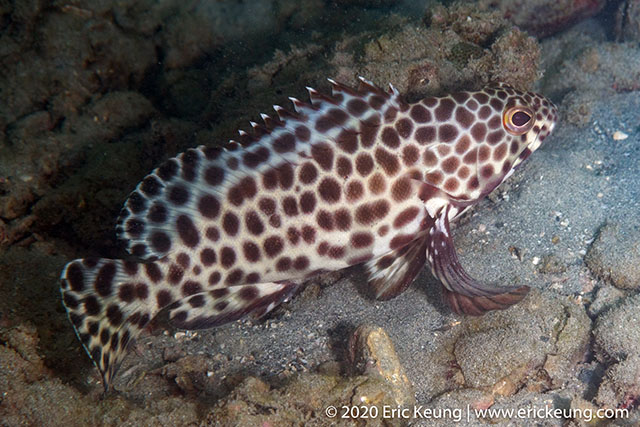| Epinephelidae (Groupers) |
| 40 cm TL (male/unsexed) |
|
reef-associated; marine; depth range - 50 m |
| Western Pacific: Japan to Australia. Unknown from the Indian Ocean except for the Andaman Islands record (as Serranus merra). Unreported from islands of Micronesia, Melanesia and central Pacific. Often misidentified as Epinephelus macrospilos or Epinephelus hexagonatus. |
|
Dorsal spines (total): 11-11; Dorsal soft rays (total): 16-18; Anal spines: 3-3; Anal soft rays: 8-8. Distinguished by the following characteristics: whitish color; head, body and fins with numerous large close-set hexagonal to roundish dark brown to blackish spots; ctenoid body scales except cycloid dorsoanteriorly above lateral line, on thorax and abdomen; body with auxiliary scales; greatest depth of body 2.7-3.2 in SL; rounded caudal fin; pelvic fins, 1.7-2.1 in head length (Ref. 90102); head length 2.3-2.6 times in SL; evenly curved dorsal head profile; snout subequal to eye diameter, snout length 4.6-5.3 times in HL; rounded preopercle or subangular; upper edge of operculum almost straight; posterior nostril diameter about twice that of anterior nostrils; maxilla reaches to or past vertical at rear edge of eye; 2-3 rows of teeth on midlateral part of lower jaw; lower jaw barely projecting in front of upper jaw (Ref. 89707). |
| Inhabits inshore silty reefs; there are no records from depths greater than 50 m. Feeds on shrimps, small fishes, worms and crabs (Ref. 89707). The enlarged fleshy pectoral fins appear to have resulted from its habit of sitting on the substrate. Solitary (Ref 90102). |
|
Least Concern (LC); Date assessed: 23 November 2016 Ref. (130435)
|
| reports of ciguatera poisoning |
Source and more info: www.fishbase.org. For personal, classroom, and other internal use only. Not for publication.
